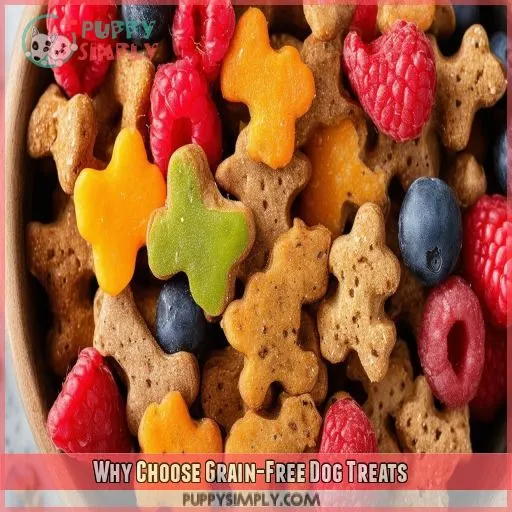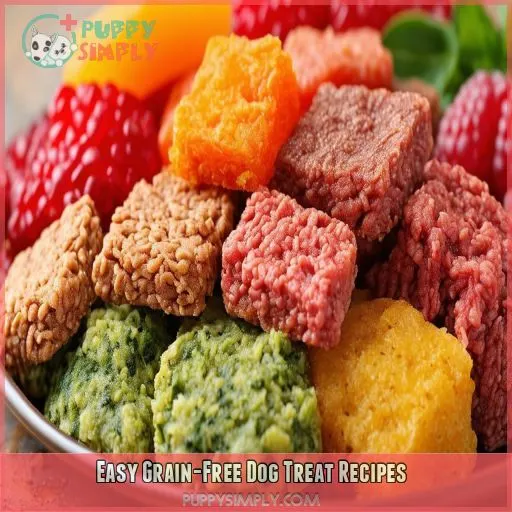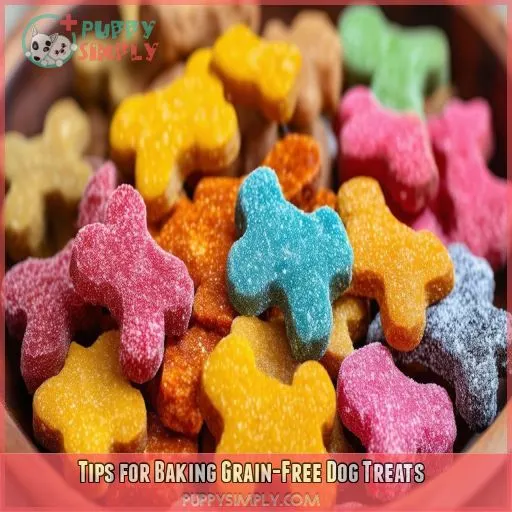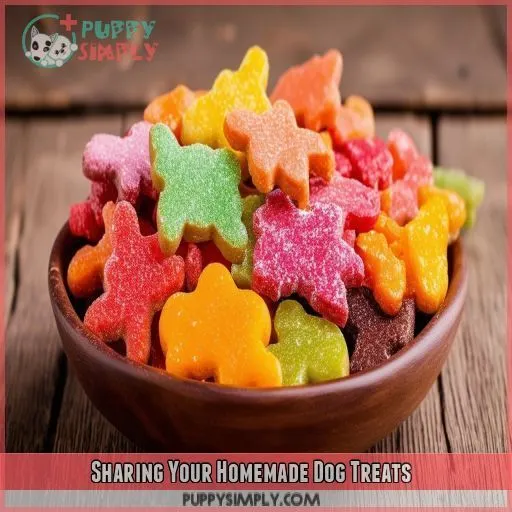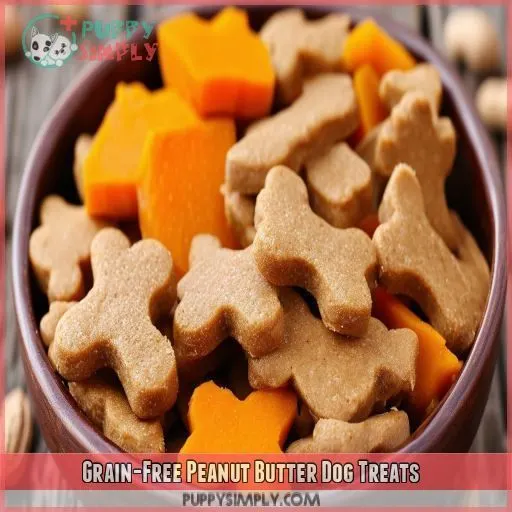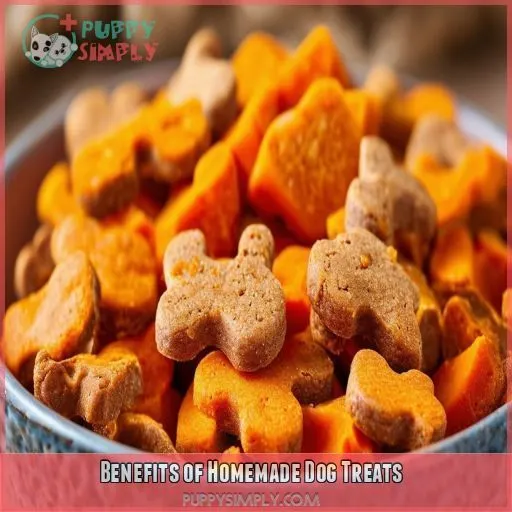This site is supported by our readers. We may earn a commission, at no cost to you, if you purchase through links.
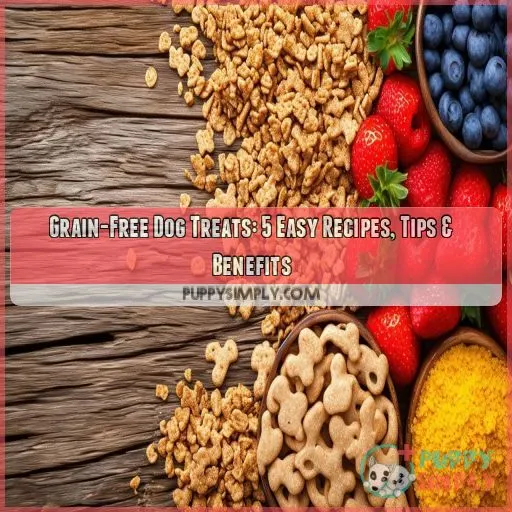
Worried about wheat? Say no more! These treats are crafted with care, swapping grains for healthier alternatives.
Key Ingredients:
- Peanut Butter: Natural protein punch, full of healthy fats and essential vitamins.
- Sweet Potato: Packed with vitamins A and C, plus fiber for healthy digestion.
- Chickpeas: A great source of plant-based protein and complex carbohydrates.
A perfect recipe for a happy, healthy pup!
Let me know if you want me to tweak it or add something extra. Always happy to help!
Table Of Contents
- Grain-Free Dog Treat Ingredients
- Easy Grain-Free Dog Treat Recipes
- Tips for Baking Grain-Free Dog Treats
- Sharing Your Homemade Dog Treats
- Grain-Free Peanut Butter Dog Treats
- Benefits of Homemade Dog Treats
- Considerations for Dog Treats
- Frequently Asked Questions (FAQs)
- What are grain free dog treats made of?
- What is the downside to grain free dog food?
- Should I give my dog grain free treats?
- What are the healthiest ingredients for dog treats?
- Are grain-free treats more expensive?
- How do I know if my dog needs grain-free?
- Can I use almond butter instead of peanut butter?
- Whats the best way to store homemade dog treats?
- How do I know if my dog is allergic to grains?
- Conclusion
Key Takeaways
- Grain-free dog treats are wholesome, tasty, and packed with natural ingredients like peanut butter, sweet potatoes, and chickpeas, offering a range of health benefits for your furry friend.
- These treats are a safer option for dogs with sensitivities to grains, helping them avoid itching, digestive issues, and skin problems caused by common allergens like wheat, corn, and soy.
- You can easily whip up a batch of grain-free dog treats at home, saving money and ensuring your pup enjoys healthy, delicious snacks. It’s a fun bonding experience too!
- There are plenty of flavor and ingredient options to choose from, and you can even get creative with cookie cutters and toppings. Share your creations with fellow dog lovers and spread the joy!
Grain-Free Dog Treat Ingredients
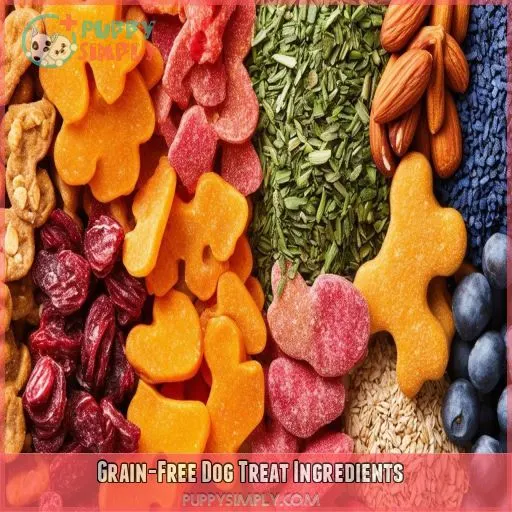
Grain-Free Dog Treat Ingredients
When it comes to whipping up tasty treats for your furry friend, choosing the right ingredients is key. You want to use simple, wholesome ingredients that are naturally grain-free and packed with health benefits for your pup.
Sweet Potato Benefits for Dogs
Sweet potatoes are a superfood for dogs, offering a range of health benefits. They’re an excellent source of fiber, supporting gut health and aiding digestion. Packed with vitamin A, sweet potatoes promote healthy vision and boost the immune system. This makes them a nutritious and wholesome ingredient in grain-free dog treats.
Peanut Butter Nutrition for Canines
Peanut butter is a tasty and nutritious treat for dogs, packed with healthy fats and protein.
It’s a great source of energy and can help keep your dog’s coat shiny and healthy.
When choosing peanut butter, opt for natural, unsalted varieties to avoid unnecessary additives.
Some brands even offer peanut butter specifically formulated for dogs, ensuring a safe and delicious treat.
Coconut Flour Advantages
coconut flour is a gluten-free, grain-free alternative to traditional flours, offering a range of benefits for your dog’s health.
It’s naturally derived from coconut meat and is a good source of healthy fats, which can give your dog’s coat a shiny boost.
Coconut flour is also a great option for dogs with sensitive stomachs or grain allergies, as it’s easy to digest and free from common allergens like wheat, corn, and soy.
It’s a versatile ingredient that can be used in a variety of dog treat recipes, adding a touch of sweetness and a unique flavor that dogs love.
Chickpea Flour Protein Content
Chickpea flour is a key ingredient in grain-free dog treats, offering a high protein content that’s essential for your pup’s health.
It’s a gluten-free option, perfect for dogs with sensitive tummies, and provides digestive benefits that keep their tummies happy.
This flour packs a nutritional punch, ensuring your furry friend gets the fuel they need to stay energetic and healthy.
It’s a versatile ingredient, ideal for whipping up homemade pet treats with a boost of protein.
Banana as a Healthy Additive
Bananas are a great natural sweetener and a healthy additive to your dog’s treats. They provide potassium, vitamins, and fiber, and most dogs love the taste. Here are some key benefits of adding bananas to your dog’s diet:
- Natural sweetness without added sugar
- Good source of potassium, which is essential for nerve and muscle function
- High in fiber, which can aid digestion and promote a healthy gut
- Contain vitamins and antioxidants that boost your dog’s overall health
Why Choose Grain-Free Dog Treats
Many dogs have sensitivities to grains, so grain-free treats are a safer, healthier option. This guide will explain the benefits of grain-free dog treats and provide tips and recipes for creating your own.
Common Grain Allergies in Dogs
Many dogs have sensitivities to grains, including wheat, corn, and soy. These common allergens can cause itching, digestive issues, and skin problems. By choosing grain-free treats, you can help your pup avoid these issues and enjoy a healthier, happier life.
Health Risks of Grain-Based Ingredients
Many dogs have sensitivities to grains, which can lead to allergic reactions and health issues. Common grain-based ingredients like all-purpose flour and oat flour may trigger these allergies. By choosing grain-free dog treats, you can avoid exposing your pup to potential allergens and keep them safe from the associated health risks.
Benefits of Natural Ingredients
There are plenty of reasons to go natural with your dog’s treats. It’s not just about what’s trending, it’s about what’s best for your furry friend. Here’s why:
- Improved Health: Natural ingredients are packed with nutrients, vitamins, and minerals that support your dog’s overall health.
- Allergy Prevention: Many dogs have sensitivities to grains, so grain-free treats lower the risk of allergic reactions.
- Better Digestion: Natural, grain-free treats are often easier for dogs to digest, leading to healthier tummies and happier pups.
- Long-Term Benefits: By choosing natural ingredients, you’re investing in your dog’s long-term health and potentially reducing the risk of issues like obesity, diabetes, and heart disease.
Customization for Dietary Needs
Grain-free dog treats offer the perfect solution for catering to your dog’s unique dietary needs. Many dogs have sensitivities to grains, so opting for grain-free treats helps you avoid potential allergens. This is especially important if your furry friend has specific allergies or dietary restrictions. By choosing grain-free, you can provide a safe and healthy snack option for your pup.
Easy Grain-Free Dog Treat Recipes
Easy Grain-Free Dog Treat Recipes
Whipping up tasty treats for your pup is a breeze with these simple grain-free recipes. You’ll find options that are delicious and packed with healthy, natural ingredients.
Simple 5-Ingredient Recipe
You and your pup will love this simple 5-ingredient recipe for grain-free dog treats. It’s an easy, cost-effective way to treat your dog to something healthy and delicious.
- Sweet potato
- Peanut butter
- Coconut flour
- Banana (optional)
- Pumpkin puree (optional)
- Preheat oven to 350 degrees Fahrenheit.
- Combine ingredients in a mixing bowl and form a dough ball.
- Roll out the dough and cut into desired shapes.
- Bake for 12-15 minutes.
- Get creative with cookie cutters for fun shapes.
- Experiment with different flavor combinations.
- Share your creations with fellow dog lovers and their four-legged friends!
Cost-Effective Alternative to Store-Bought
Let’s face it, store-bought treats can be pricey.
This is where homemade treats come to the rescue.
This recipe uses simple, wholesome ingredients that are kind to your wallet and your dog’s tummy.
You’ll be surprised at how much you can save by whipping up a batch of these grain-free goodies.
Plus, you’ll have the peace of mind knowing exactly what goes into your furry friend’s treats.
Customization Options for Flavor and Texture
The fun part about making homemade dog treats is the ability to customize them to your dog’s preferences. You can experiment with different flavors and textures to find the perfect combination that your pup will go crazy for. Here are some ideas to get you started:
- Flavor Options: Try adding pureed pumpkin or banana for a natural sweetness, or peanut butter for a nutty flavor. You can also experiment with other nut butters like almond or cashew butter.
- Texture Variety: Play around with the texture by adding more or less flour. A higher flour content will result in a drier, crumbly texture, while using less flour creates a chewier, more moist treat.
- Mix and Match: Don’t be afraid to mix and match different ingredients to create unique combinations. For example, you could combine pumpkin and cinnamon for a fall-inspired treat or peanut butter and banana for a classic combo.
- Experiment with Herbs: Fresh herbs like parsley, mint, or rosemary can add a burst of flavor and have the added benefit of improving your dog’s breath.
- Topping Treats: Drizzle some melted peanut butter or yogurt on top of the treats for an extra special touch. You can even sprinkle on some chopped nuts or seeds for added crunch.
Large Batch Yield for Long-Term Storage
The recipe yields a large batch, so you can make plenty of treats for your pup and their friends.
If you’re baking for one, no worries! These treats store well.
Keep them in an airtight container in the freezer for up to two weeks.
That way, you can treat your dog to fresh-baked goodies whenever they deserve a little something extra.
Tips for Baking Grain-Free Dog Treats
Now that you’ve mastered a few recipes, it’s time to fine-tune your baking skills. Discover the do’s and don’ts of baking grain-free dog treats, from cooling and storage tips to ingredient allergy considerations.
Cooling and Storage Instructions
Cooling and storage are essential steps in the dog treat-making process. Here are some tips to help your grain-free dog treats stay fresh and safe for your furry friend to munch on:
- Let the treats cool completely before serving or storing.
- Store the treats in an airtight container at room temperature.
- For longer-term storage, consider freezing the treats.
Ingredient Allergy Considerations
It’s important to be mindful of the ingredients you use, as some dogs may have allergies or sensitivities. Always check with a vet if you’re unsure.
Fun Shape Options With Cookie Cutters
When baking dog treats, don’t forget to have some fun with shapes!
You can find a variety of cookie cutters online, from classic bone shapes to more whimsical designs.
Get creative and experiment with different cutters for special occasions, like dog birthday parties.
Use small cutters for bite-sized treats, perfect for training rewards.
The shape won’t change the taste, so your dog will love them either way!
Experimenting With Flavor Combinations
The dog treat baking community is a treasure trove of inspiration for flavor combos. Check out dog treat baking blogs, forums, and online hacks for ideas.
You can go wild with add-ins like cinnamon, turmeric, or pumpkin for a savory kick. Or, opt for sweet touches with mashed banana or applesauce. Just remember to steer clear of harmful ingredients like xylitol, grapes, or raisins.
Sharing Your Homemade Dog Treats
Now that you’ve whipped up a batch of delicious and healthy grain-free dog treats, it’s time to share the love! You can spread the joy of homemade treats beyond your furry friend by gifting them to fellow dog owners or donating them to local animal shelters.
Posting your recipes and tips online is another great way to engage with the pet parent community and encourage others to try making their own treats.
Gifting to Fellow Dog Owners
Homemade dog treats make the perfect gift for dog lovers. If you’re looking to share your tasty creations with fellow dog owners, here are some ideas:
- Gifting to friends and family: Share your homemade treats with dog-owning friends and family. They’ll appreciate the thoughtful gesture, and their pups will thank you!
- Online engagement: Join online communities and forums for pet parents. Share your recipes, tips, and experiences. You might even make some new furry friends!
- Social media sharing: Spread the word on social media using hashtags like #grainfreedogtreats. Show off your creations and connect with other dog treat bakers.
Donating to Local Animal Shelters
You can also spread the love by donating your homemade treats to local animal shelters or rescue organizations. This act of kindness can brighten the days of shelter dogs awaiting their forever homes. It’s a great way to support the community and make sure your treats don’t go to waste.
Before donating, make sure you package the treats nicely and maybe include a list of ingredients to address any allergy concerns.
Sharing Recipes and Tips Online
You can also join online communities dedicated to dog treat baking.
These communities offer a wealth of dog treat baking advice, with people sharing their own recipes, successes, and failures.
You’ll be able to ask questions, get feedback, and connect with other dog lovers who share your passion for homemade treats.
These communities are a great way to stay inspired and motivated in your treat-making journey, and you might even make some new furry friends along the way!
Spreading the Word on Healthy Treats
Spreading the word about your delicious and healthy dog treats is a great way to share your passion with others. Consider the following ideas:
- Gifting: Homemade dog treats make paw-some gifts for fellow dog owners. Package them cutely and spread joy among your dog-loving friends.
- Donating: Animal shelters and rescue organizations are always in need of treats for their furry residents. Reach out and offer your homemade goodies to support their cause.
- Online engagement: Join online communities and forums dedicated to pet care and homemade treats. Share your recipes, tips, and experiences. Use hashtags like – Social media sharing: Post photos and videos of your baking adventures, cute doggos enjoying the treats, and creative ways to package and gift them. Engage with other pet parents and build a community around healthy, homemade dog treats.
Grain-Free Peanut Butter Dog Treats
Peanut butter is a popular ingredient in dog treats, but it’s important to make sure that the treats are also grain-free to accommodate dogs with grain sensitivities. This section will cover the benefits of using peanut butter, as well as a simple recipe for grain-free peanut butter dog treats that your pup is sure to love.
Healthy Fats and Protein Content
Now that you’ve shared your delicious creations, let’s take a closer look at the nutritional value of these peanut butter pumpkin dog treats.
These treats are packed with healthy fats and protein, ensuring your pup stays energetic and healthy. Here’s a breakdown:
- Peanut Butter: It’s not just tasty, but also provides healthy fats for your dog’s overall health and a shiny coat.
- Protein Power:
- Eggs: These are a great source of protein and help bind the ingredients together.
- Balanced Nutrition:
- Banana: While adding sweetness, bananas also contribute to a balanced nutritional profile with their vitamins and minerals.
Chickpea Flour and Coconut Flour Benefits
Chickpea flour and coconut flour are two key ingredients in grain-free peanut butter dog treats. They’re a healthy alternative to grain-based flours and offer some great benefits for your pup.
Chickpea flour is a protein source, helping to bind the treats together. Coconut flour, on the other hand, is packed with healthy fats that can improve your dog’s coat and overall digestive health.
Banana and Egg Additives
Bananas add a burst of sweetness and moisture to the treats, while eggs act as a binding agent and provide protein. Together, they create a tasty and nutritious snack for your pup. This dynamic duo is a great way to add some extra flavor and health benefits to your dog’s treats, and they’re likely ingredients you already have on hand.
Avoiding Common Allergens
When making grain-free peanut butter dog treats, it’s important to avoid common allergens to keep your pup safe and healthy. Here are some tips:
- Be mindful of ingredients: Some common allergens for dogs include wheat, corn, and soy. Avoid using ingredients that contain these allergens to prevent any potential reactions.
- Check for specific allergies: Each dog is unique, and some may have specific allergies or sensitivities. Consult with a veterinarian to identify any allergens your dog may have, and tailor your treat recipe accordingly.
- Opt for alternative flours: Instead of using grain-based flours, choose alternative flours like chickpea or coconut flour. These provide a safe and healthy base for your treats.
Benefits of Homemade Dog Treats
Making your own dog treats is a cost-effective, healthy option that lets you avoid artificial additives. It’s also a fun bonding experience with your dog, letting you spend quality time together in the kitchen.
Cost-Effective and Healthy Alternative
Making your own dog treats is a cost-effective way to provide healthy snacks for your pup. You can save money by using simple, wholesome ingredients that you may already have in your kitchen. Plus, you can avoid the high prices of store-bought grain-free treats, which often come in small quantities.
With homemade treats, you’re in control of the ingredients. You can make sure they’re healthy and safe for your dog, free from artificial flavors, colors, and preservatives. It’s a paws-itive way to show your furry friend some love!
Bonding Experience With Your Dog
Baking homemade dog treats is a fun activity that can strengthen the bond with your furry friend.
It’s a shared experience that brings you both joy and creates lasting memories.
Your dog will love being involved in the process, from mixing the ingredients to excitedly awaiting the treats coming out of the oven.
It’s a great way to show your love and dedication to your four-legged friend.
Avoiding Artificial Additives
One of the biggest benefits of making your own dog treats is that you can avoid artificial additives and preservatives. Here are four reasons why this is a good idea:
- Peace of Mind: You know exactly what goes into the treats, so there are no nasty surprises.
- Health Benefits: Artificial additives have been linked to health issues in dogs, so it’s best to steer clear.
- Natural Goodness: By using natural, wholesome ingredients, you provide your pup with the nutrients they need.
- Customized Creations: You can tailor the treats to your dog’s unique taste preferences and dietary needs, creating a perfect, personalized snack.
Considerations for Dog Treats
When making homemade dog treats, it’s important to think about your dog’s individual needs and dietary restrictions. Always consult a veterinarian before introducing new foods to your pet, and be mindful of potential allergens.
Individual Needs and Dietary Restrictions
When preparing homemade treats, always consider your dog’s individual needs and dietary restrictions. Be aware of potential allergens like wheat, corn, and soy, and avoid ingredients that could trigger reactions. Remember to give treats in moderation as part of a balanced diet. After all, too much of a good thing can be, well, too much!
Vet Consultation for New Foods
When introducing new foods to your dog’s diet, it’s always a good idea to talk to your vet first.
They can give you expert advice on whether the ingredients in your chosen recipe are right for your dog’s individual needs.
This is especially important if your dog has any known allergies or dietary restrictions.
Allergy Awareness and Moderation
When preparing homemade dog treats, it’s important to be mindful of potential allergens.
Just like us, dogs can have allergies or sensitivities to certain ingredients.
The most common allergens in dogs include wheat, corn, soy, and dairy.
If your dog has a history of allergies, it’s best to consult a vet before introducing new treats.
Safety Precautions for Treat Consumption
It’s important to keep a watchful eye on your pup when they’re chowing down on treats.
You don’t want them to choke or gobble up something that might upset their tummy.
Always supervise treat time, especially if your dog is a speedy gobbler or has a sensitive stomach.
This simple step makes sure their safety and lets you quickly step in if they need help.
Frequently Asked Questions (FAQs)
What are grain free dog treats made of?
Grain-free dog treats are made from ingredients like coconut flour, peanut butter, sweet potato or pumpkin puree, and shredded carrots. They’re free from gluten, grains, and common allergens like wheat, corn, and soy.
What is the downside to grain free dog food?
While grain-free dog food can help with food sensitivities, it may not be ideal for weight control. It can be higher in calories and carbs, leading to unintentional weight gain, especially in less active dogs.
Should I give my dog grain free treats?
If your dog has grain sensitivities, go for grain-free treats. These treats use alternative ingredients like chickpea and coconut flour. Always consult a vet before changing your dog’s diet.
What are the healthiest ingredients for dog treats?
The healthiest dog treats are made with whole, natural ingredients. Think fresh veggies like carrots, sweet potato, and cucumber. Fruits like blueberries and apples are also great. Single-source proteins like chicken, fish, or organ meats are recommended.
Are grain-free treats more expensive?
You might be surprised to learn that grain-free dog treats are often more affordable than store-bought options. Many companies offer discounts and free shipping on these treats, making them a cost-effective choice.
How do I know if my dog needs grain-free?
Did you know that grain-free diets can be higher in fat and calories, which can lead to weight gain, especially in dogs with a history of health issues?
You should consider switching your dog to a grain-free diet if they’ve an allergy to grain that’s causing skin problems like red patches, itchy skin, and hair loss. Consult your vet for advice.
Can I use almond butter instead of peanut butter?
Yes, you can use almond butter instead of peanut butter. But, like peanut butter, it should be fed cautiously and in moderation to avoid stomach upset and weight gain.
Whats the best way to store homemade dog treats?
Keep those tail-wagging treats fresh! Store homemade dog treats in an airtight container at room temperature for up to 3 days, or freeze for longer-term storage, up to 2 weeks.
How do I know if my dog is allergic to grains?
Watch for behavioural changes, like scratching, uneasiness, or lethargy. Grain allergies can also cause digestive issues, frequent ear infections, and skin irritation.
Conclusion
So, roll up your sleeves and get baking!
Your furry friend will thank you for these delicious and nutritious grain-free treats.
With these recipes and tips, you’re now equipped to whip up wholesome treats that cater to your pup’s dietary needs, steering clear of grains and common allergens.

